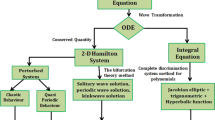Abstract
Harmonic balance method is employed for analytic periodic motions in the Duffing oscillator. Traditionally, one used the perturbation method to discuss the nonlinearity of periodic motions in the Duffing oscillator. For decades, one cannot achieve the appropriate analytical solutions of periodic motions. The harmonic balance method with prescribed-computational accuracy will be used, for a better understanding of nonlinear characteristics of periodic motions in the Duffing oscillator. In this method, the finite Fourier series with coefficient varying with time is adopted to approximately describe periodic motions in nonlinear dynamical system. The dynamical system of the coefficients of the Fourier series is obtained. The equilibrium of such a system gives the constant coefficients in the Fourier series. Thus, the periodic solution is obtained and the stability and bifurcation of the periodic motions can be determined. The analytic periodic motions should be further revisited, since the Duffing oscillator is extensively applied in engineering, and the comprehensive investigation of such periodic motions in the Duffing oscillator is necessary and significant. In this paper, the further analytic solutions of periodic motion in the Duffing oscillator will be investigated, and frequency amplitude characteristics will be discussed, and numerical simulation of periodic motions will be presented. Some new roads from periodic motions to chaos based on generalized harmonic balance method are found, such as independent period-2 motions to chaos and independent period-4 motions to chaos.













Similar content being viewed by others
References
Luo ACJ (2012) Continuous dynamical systems. HEP-L&H Scientific, Glen Carbon
Luo ACJ, Huang JZ (2012) Approximate solutions of periodic motions in nonlinear systems via a generalized harmonic balance. J Vib Control 18:1661–1874
Luo ACJ, Huang JZ (2012) Analytical dynamics of period-m flows and chaos in nonlinear systems. Int J Bifurc Chaos 22(4):91–116
Luo ACJ, Huang JZ (2013) Analytical solutions for asymmetric periodic motions to chaos in a hardening Duffing oscillator. Nonlinear Dyn 72:417–438
Luo ACJ, Han RP (1997) A quantitative stability and bifurcation analyses of a generalized Duffing oscillator with strong nonlinearity. J Frankl Inst 334B:447–459
Han RP, Luo ACJ (1996) Comments on “Subharmonic resonances and criteria for escape and chaos in a driven oscillator”. J Sound Vib 196:237–242
Luo ACJ, Han RP (1999) Analytical predictions of chaos in a nonlinear rod. J Sound Vib 227:523–544
Huang ZL, Zhu WQ, Suzuki Y (2000) Stochastic averaging of strongly non-linear oscillators under combined harmonic and white-noise excitations. J Sound Vib 238:233–256
Rong H, Xu W, Meng G, Fang T (2001) Response of a Duffing oscillator to combined deterministic harmonic and random excitation. J Sound Vib 242:362–368
Xu W, He Q, Fang T, Rong H (2004) Stochastic bifurcation in Duffing system subject to harmonic excitation and in presence of random noise. Int J Non-Linear Mech 39:1473–1479
Yu JS, Lin YK (2004) Numerical path integration of a non-homogeneous Markov process. Int J Non-Linear Mech 39:1493–1500
Kerschen G, Worden K, Vakakis AF, Golinval JC (2006) Past, present and future of nonlinear system identification in structural dynamics. Mech Syst Signal Process 20:505–592
Li LM, Billings SA (2010) Analysis of nonlinear oscillators using Volterra series in the frequency domain. J Sound Vib 330:337–355
Zou K, Nagarajaiah S (2015) The solution structure of the Duffing oscillator’s transient response and general solution. Nonlinear Dyn 81:291–305
Panigrahi RS, Feeny RB, Diaz RA (2015) Harmonic balance analysis of snap-through orbits in an undamped Duffing oscillator. ASME J Vib Acoust Trans 137 (Article No. 064502)
Luo ACJ, Yu B (2015) Complex period-1 motions in a periodically forced, quadratic nonlinear oscillator. J Vib Control 21:896–906
Acknowledgments
This study was found by the National Nature Science Foundation of China (NSFC) (No. 11272100).
Author information
Authors and Affiliations
Corresponding author
Appendix
Appendix
The \(F_0^{\left( m \right) } ,F_{k/m}^{\left( c \right) } ,F_{k/m}^{\left( s \right) } \) are expressed as follows:
The \(\delta \) function and sign function are
\(\delta _k^l =\left\{ {\begin{array}{ll} 1&{} {l=k} \\ 0&{} {l\ne k} \\ \end{array} } \right. \) and \(\hbox {sgn}\left( k \right) =\left\{ {\begin{array}{ll} 1&{} k\ge 0 \\ -1&{}k<0 \\ \end{array}} \right. \)
In Eqs. (18), (19), (20), the \(\delta \) functions are expressed as follows.
In the Jacobian matrix, G and H are
Rights and permissions
About this article
Cite this article
Ying, J., Jiao, Y. & Chen, Z. Further analytic solutions for periodic motions in the Duffing oscillator. Int. J. Dynam. Control 5, 947–964 (2017). https://doi.org/10.1007/s40435-016-0263-9
Received:
Revised:
Accepted:
Published:
Issue Date:
DOI: https://doi.org/10.1007/s40435-016-0263-9




